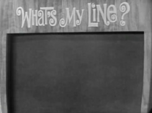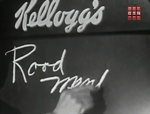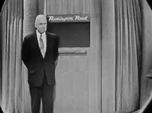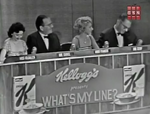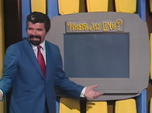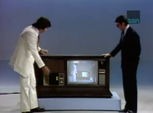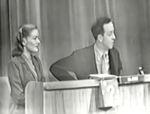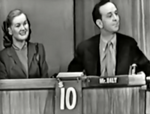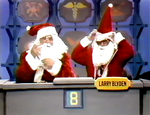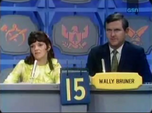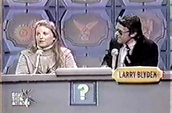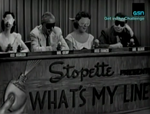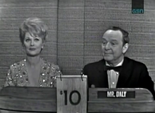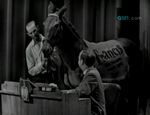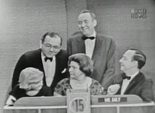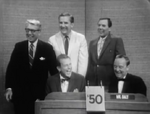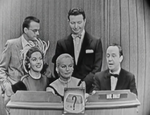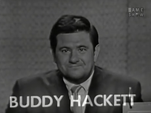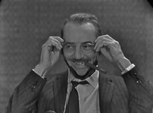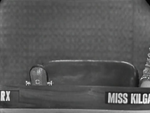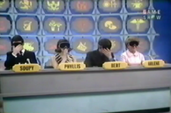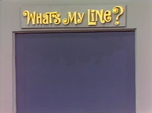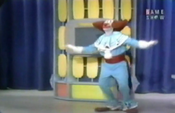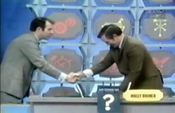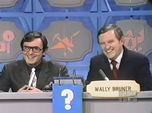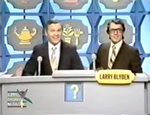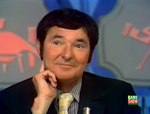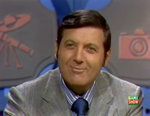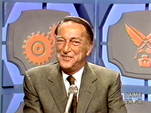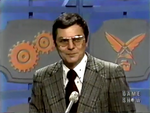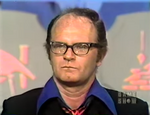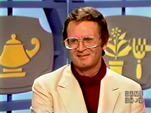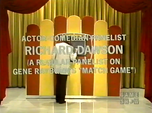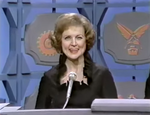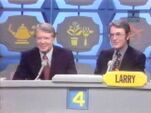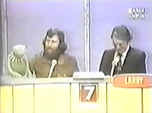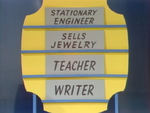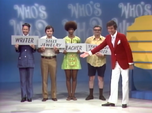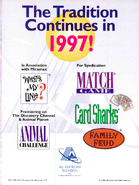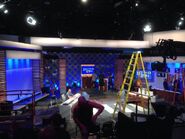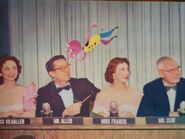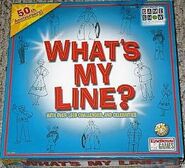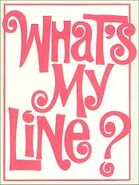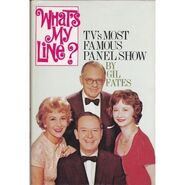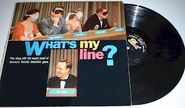| Hosts | |
| John Charles Daly (1950–1967) Wally Bruner (1968–1972) Larry Blyden (1972–1975) Harry Anderson (2000) | |
| Announcers | |
| Lee Vines (1950–1955) Hal Simms (1955–1961) Ralph Paul (1961) Johnny Olson (1961–1972) Wayne Howell (1972) Chet Gould (1972–1975) | |
| Broadcast | |
| CBS Primetime: 2/2/1950 - 9/3/1967 NBC Radio (Weekly): 5/20/1952 - 8/27/1952 CBS Radio (Weekly): 9/3/1952 - 7/1/1953Syndication (Daily): 9/9/1968 - 9/3/1975Unsold Pilot for CBS: 6/10/2000 | |
| Packager | |
| Mark Goodson-Bill Todman Productions (1950–1975) Pearson Television (2000) | |
| Distributors | |
| CBS Enterprises (1968-1971) Viacom Enterprises (1971–1975) | |
What's My Line? is the long-running panel game show where the celebrity panelists try to figure out unusual occupations of everyday people. It's famous for asking the question..."Is it bigger than a breadbox?"
Panelists[]
Regulars[]
Arlene Francis
Bennett Cerf
Dorothy Kilgallen
Soupy Sales
Fred Allen
Semi-Regulars[]
Louis Untermeyer
Richard Hoffmann
Harold Hoffman
Hal Block
Steve Allen
Martin Gabel
Dana Valery
Alan Alda
Robert Alda
Joanna Barnes
Joyce Brothers
Jack Cassidy
Bert Convy
Joel Gray
Elaine Joyce
Ruta Lee
Sam Levene
Meredith MacRae
Henry Morgan
Jerry Orbach
Gene Rayburn
Gene Shalit
Nipsey Russell
Anita Gillette
Format[]
Main Rounds[]
In each game, a contestant would enter the stage and sign in his/her name, by virtue of the host saying, "Will you enter and sign in, please?" After that, he/she sat down at a desk next to the host. The game would begin by having the home audience be shown what his/her line was, and the host afterwards told the panel a clue which was usually "deals in a service" or "self-employed," something like those.
The panelists in turn then asked yes-or-no questions to the contestant which would hopefully lead to the right line. Each time the panelist in control got a "yes" answer, his/her turn continued, but if at any time the panelist in control got a "no" answer, he/she lost his/her turn and control passed to the next panelist in line, the contestant would also receive $5. Upon a "no" answer, the host would say the famous catchphrase "# down, # to go" (Ex: 2 down, 8 to go).
Sometimes a question would have the host make a brief explanation which could lead to either a "yes" or "no" answer. A panelist could be allowed to pass his/her turn without penalty, other times, the panel could call a conference. If the panel could guess the right line, they won the game, but if they got ten no answers, the contestant stumped the panel, won the game, and a maximum total of $50. Often, the host would throw the cards over (end the game) when time was running short or any other reason.
In the syndicated run, the contestant would demonstrate or perform the product or service in question.
The Score Cards[]
In the entire original run and during Wally Bruner's stint as host, the money was printed on flip cards. The hosts would flip a card over when a panelist received a "no" answer, they would also flip all the cards over if time was running out, or any other reason. When Larry Blyden took over as host, the flip cards were replaced with slide cards built into the desk, they slid away with a press of a button. Finally, the money cards were replaced with descending numbers.
Final Round: Mystery Guest[]
After two rounds of What's My Line? were played (sometimes more), a final round was played, but a little differently. This round featured the appearance of the "Mystery Guest." This was where the panelists were blindfolded so they couldn't see the guest. The mystery guest entered and signed in as usual, and that's where the game began. As usual the panel asked yes-or-no questions, this time to try and guess the name of the mystery challenger. What made this round more different was that this time, each panelist could only ask one question per turn, hence the rule "one question at a time," and they had two to three minutes to identify the guest, depending on the amount of time left in the show. While all this was going on, the mystery guest disguised his/her voice in a variety of ways.
Some mystery guests wouldn't be famous from the entertainment field, but from other walks of life, when that happened, those guests would play in the main rounds, instead of writing their names, they would write down a big "X" referring to them as Mr. or Ms. "X." One such main round mystery guest was future President Jimmy Carter.
In the original classic version, the mystery guest still scored for no answers, while in the syndicated run, the mystery guests were no longer scored. Also in the syndicated run in later years, if a panelist made a wrong guess of the guest, he/she would be free to take his/her blindfold off. Larry would announce that rule by saying "Fates' Law prevails."
Who's Who[]
In the syndicated run, whenever there was extra time, a special game was instituted called "Who's Who." This was where four members of the studio audience were lined up on stage, and their occupations were printed on cards. Each panelist took those occupation cards gave each to the appropriate contestant (the ones who they thought had that occupation). Each time one panelist failed, another panelist took a turn. The game ended when the panel was stumped or if a panelist could place the occupations with the right contestants. $25 was awarded for each stump for a grand total of up to $100.
ADDITIONAL NOTE: The theme song from this segment of the show was originally borrowed from the short-lived 1969–1970 syndicated game show He Said She Said hosted by the late Joe Garagiola.
Proposed What's My Line? Pilots/Revivals[]
These are the eras that were made to revive the show but failed to have never aired.
1963[]
A planned network daytime version was made for CBS at the time, but original host John Charles Daly made it perfectly clear that he would not host a five-days-a-week game show. Daly was so closely associated with WML? by that point the network shelved the project instead of finding a new host.
1981[]
A version was planned at the time, pending on the success of the short-lived Robin Ward syndicated revival of To Tell the Truth in 1980. Details were sketchy as the revival never went past the talking stages and few if any other details are known, other than it was to be a five-days-a-week show.
1996[]
Produced in a joint venture between All-American Television and Miramax Films. This was also the film company's (Miramax) first foray into television production.[1]
This version was described as "a new model" that would have blended the original features such as having a celebrity panel questions contestants in an effort to guess their occupation and also having the panel blindfolded to guess the identity of a famous person with "contemporary special effects and interactive twists."
CBS reportedly committed to six episodes for its fall 1999 schedule. However, according to Miramax TV president Billy Campbell, the deal crumbled because the network decided the show was too "costly and ambitious."
2000[]
A pilot was shot on June 10, 2000 for CBS' primetime schedule hosted by the late Harry Anderson (Judge Harry T. Stone) of Night Court fame along with Catherine Bell (JAG), Bryan Cranston (Malcolm in the Middle, Breaking Bad), Betty White and Al Franken as the four panelists. It was one of three proposed shows for the network at the time. The others were another failed revival of another 50s game The $64,000 Question and the long-running reality competition series Survivor hosted by Jeff Probst. However, this pilot along with the $64,000 Question pilot were turned down for the latter show.
In the same year, another revival of the show was supposed to be made with actress Gwyneth Paltrow but was "on hold"[2]at the moment.
2008[]
This version was in the works with former Knight Rider and Baywatch star David Hasselhoff along with FremantleMedia (who owns the rights to the show)[3]but was never materialized.
2014[]
Most recently, another pilot was made for a shot in the fall 2015[4][5]season in syndication. Developed by Debmar-Mercury with production studio FremantleMedia North America (which again owns the rights to this show) was supposed to feature the famed Improv theatre comedy group called "The Second City" as the four panelists. However, it was also never materialized.
What's My Line? Live On Stage[]
Since 2004, What's My Line? came back as a live stage show hosted by J. Keith van Straaten. People who appeared on the original series along with relatives of those appeared made appearances on the live show. The show went on a brief hiatus giving host Straaten time to move from Los Angeles to New York City from July 2006 to June 2007.
Mystery Taster (The Rachael Ray Show)[]
On certain episodes of the popular talk show The Rachael Ray Show, they had their own version of the Mystery Guest game called "Mystery Taster." This was where a celebrity or a group of celebrities past or present came down the elevator while Rachael stood in the corner of her kitchen so she wouldn't see. She asked interesting questions (not restricted to yes or no) hopefully to lead her to the identity of the taster. There were two rounds of Mystery Taster, the first of which being at the start of the show, and the other was later in the show. After the second round in which the identity of the Mystery Taster was eventually revealed, Rachael & the surprise guest took some time to chat at the kitchen table.
Gallery[]
Press Pictures[]
Production Slates[]
1968-75 Era
Merchandise[]
Board Games[]
The original incarnation based on the original 1950s CBS version was released by Lowell in 1955.
The second incarnation based on the 1968 syndicated version was released by Whitman in 1969.
To celebrate the show's 50th anniversary at the time, a third edition was released by Endless Games in 2001.
Books[]
A book based on the show was created by Gil Fates and was released by Prentice Hall in 1978. In the book the producer of the classy panel show looks back over the quarter-century run of the series. (NOTE: Original host John Daly and panelists Arlene Francis, Bennett Cerf and Dorothy Kilgallen are on the cover of the book.)
Record Album[]
A record album based on the show was released by Dot in 1955, where audio recordings of eight "mystery guest" segments as originally seen on the show can be heard on the album.
Cancelled Merchandise[]
A What's My Line? DVD game was going to be released by Imagination Entertainment in the mid to late 2000s but it never got made or released.
A DVD set titled The Best of What's My Line? was planned by BCI in 2009 but it never got released.
Studios[]
Network Version[]
Grand Central Studios, New York City, NY (Early Episodes)
CBS Studios 52, 59, and 50, New York City, NY (Later Episodes)
Syndicated Version[]
Ed Sullivan Theater, New York City, NY (1968–1971)
NBC Studios 8H and 6A, New York City, NY (1971–1975)
CBS Television City (2000 pilot)
International versions[]
Australia[]
An Australian version hosted by John Barnes debuted on station TCN-9 in 1956 during the opening week of Australian television and ran until 1958. It was replaced by a long-running version of To Tell the Truth. The archival status of this version is unclear.
Brazil[]
The Brazilian version of What's My Line? was called Adivinhe o que ele Faz? ("Guess What He Does?") and was hosted by Heloísa Helena. On December 16, 1956, Helena appeared as a contestant on the American version.
Canada (French-speaking)[]
Chacun son métier ("To Each His Job" or "To Each His Trade") ran on Radio-Canada from 1954 to 1959 and was hosted by Louis Morisset.
On January 23, 1955, panelist Nicole Germain appeared as a contestant in the first round on the American version, then sat on the panel next to Bennett Cerf for the second round.
On January 18, 1959, near the end of the Canadian run, host Morisset appeared as a contestant on the American version.
Germany[]
Was bin ich? ("What am I?") ran on ARD (First German Television) from 1955 to 1958 and from 1961 to 1989 with Robert Lembke (a Bavarian) as host. Lembke was head of the news division of the public Bavarian Broadcasting Establishment Bayerischer Rundfunk (BR) at the time and had bought the rights to the series during a visit to the BBC in 1954.
The best-known panel consisted of district attorney Hans Sachs, actress Marianne Koch, TV announcers Annette von Aretin and Anneliese Fleyenschmidt, and Guido Baumann, head of the entertainment division of Swiss radio and TV station DRS. Austrian TV announcer Ingrid Wendl would usually fill in for von Aretin if the latter was not available.
Guests received 5 Deutsche Mark (DM) for each "no" answer and the panel was allowed 10 "no" answers. Prize money was given in a porcelain piggy bank, and Lembke used to insert a 5 DM coin into the Bank's slot for each "no," producing a loud, characteristic sound. In relation to this, Lembke's most famous line "Welches Schweinderl hätten S' denn gern?" ("Which piggy would you like to have?," spoken in Lembke's strong Bavarian accent), which referred to differently-colored piggy banks.
Playing rules were almost identical to the original American rules on What's My Line with two notable exceptions:
- Before starting into the line of questions, Robert Lembke would ask the regular guests to perform a "typical gesture" that would occur regularly in their line of working, but wasn't recognizable too easily. A hairdresser, for example, would not perform the gesture of combing a customer's hair but of simply lifting a strand of hair before using the comb.
- The "celebrity guest of honor" (German equivalent to the "mystery celebrity guest") would receive neither a piggy bank nor money to fill it, but accessories to something he would indulge in privately, ascending in value. So, if a secret guest of honor would (e.g.) be a painter in his private time, he would receive something like a small paint brush on the first "no" up to an easel on the tenth "no." A keen reader would receive up to ten books by his favorite authors etc.
The series returned from 1961 and ran until Lembke's unexpected death in 1989. The series returned as a weekly program on Kabel 1 from 1999 to 2005, hosted by Björn Hergen Schimpf. The panel consisted of entertainer/comedians Herbert Feuerstein and Tanja Schumann, talk-show host Vera Int-Veen, and former German minister of labour and social affairs Norbert Blüm.
Indonesia[]
The Indonesian version is called Kuis Siapa Dia ("Who He/She Is"). First premiered on August 3, 1992 until June 26, 1998 then was revived on March 1 until August 26, 2013 on TVRI, it was one of the most successful and legendary quiz show in Indonesia. Created by Ani Sumadi. After 15 years, the show is aired again on Trans 7 TV station starting from October 27, 2014 until March 1, 2015. The hosts were Aom Kusman, Denny Chandra and Ananda Omesh.
Lithuania[]
The Lithuanian version began in late 2010 under the name "Kas tu toks?" (Who Are You?). It is broadcast on Lietuvos Rytas Television.
Puerto Rico[]
A Puerto Rican version aired, and Puerto Rican panelist Sylvette de Aldrey appeared as a contestant on the American version of the program on the 1955 Christmas episode.
South Korea[]
The South Korean version began in 1956 by the South Korean government and run as a non-profit organization. On July 28, 1963 a panelist from this version, Miss Keun Oh Kim, appeared as a contestant on the American version.
Spain[]
The Spanish version was called Adivine su vida ("Guess Your Life") and ran from 1960 to 1961.
Sweden[]
Sweden aired a version that was called Gissa mitt jobb ("Guess my profession"), and it was televised in 1960 and again in 1974.
United Kingdom[]
A British version aired on BBC Television Service from 16 July 1951 to 13 May 1963. The host (called "chairman") on the premiere was Gilbert Harding, who was replaced by Eamonn Andrews for the remainder of the run. Regular panelists included Harding, Isobel Barnett, Barbara Kelly, David Nixon and Cyril Fletcher, while Katie Boyle, Jerry Desmonde, Ghislaine Alexander, Marghanita Laski, Frances Day and Elizabeth Allan were among the others.
There was also a radio version for British listeners on Radio Luxembourg. As Andrews and Harding had exclusive contracts with the BBC, their places were taken by Peter Martyn (later Bernard Braden) and Richard Attenborough. Original-series regulars Nixon, Barnett and Kelly also appeared.
The series returned, on BBC2 with David Jacobs as host, from 23 August 1973 to 18 May 1974. Regular panelists were William Franklyn, Isobel Barnett (Lady Barnett), Kenneth Williams, and Anna Quayle, later in the run, Quayle was replaced by Nanette Newman.
Eamonn Andrews returned to host a revival on ITV from 26 March 1984 with John Benson as announcer. This version aired at night and, although mainly recorded, some episodes were screened live. Taped episodes may be identified as opening with "Tonight from London it's time for What's My Line?," while those broadcast live began with "Live from London." Regular panelists included Angela Rippon, Ernie Wise, George Gale, Jeffrey Archer, Barry Sheene, novelist Jilly Cooper, and Patrick Mower. Mower was starring in a West End theatre production at the time the series aired and for the live editions, was seen walking off set as the final credits rolled. After Andrews died in 1987, actress Penelope Keith assumed the role of chairperson in 1988. Angela Rippon took over hosting duties after Keith left until the show ended on 28 August 1990. The Keith and Rippon episodes were taped and screened in ITV's daytime schedule.
The show was revived by HTV West and Meridian from 20 September 1994 to 17 December 1996 hosted by Emma Forbes. A special one-off edition hosted by Hugh Dennis was produced for BBC Four in 2005, as part of a season about British culture in the decade following World War II, along with an episode of the original series, from 5 October 1957.
A one-off episode aired on the BBC website on 7 March 2011 as part of the BBC's Red Nose Day fundraiser 24 Hour Panel People. Stephen K. Amos served as presenter, with David Walliams, Christopher Biggins and Holly Walsh on the panel. Tom Felton was the mystery guest.
A parody of this show, entitled "What's My Crime?," appeared in The Hundred and One Dalmatians by Dodie Smith and its film adaptation. It features a contestant whose crime was to have stolen two hundred bath plugs from hotels.
Venezuela[]
The Venezuelan version was called Mi Trabajo y Yo ("My Job and I"). On December 24, 1961 the director and moderator of this version, Jacques Lemoine, appeared as a contestant on the American version.
Rating[]
Music[]
1950
1st Open - "Melody in Moccasins" by Wilfred Burns
2nd Open - by Sacha Burland and His Orchestra
Close - "Roller Coaster" by Henry Rene and His Orchestra
1968 - by Charles Fox and Score Productions
1972 - by Charles Fox and Score Productions
The Who's Who music of the 1971 version was the main from He Said She Said.
2000 - Unknown
Spinoffs[]
Figure it Out – a kid's version on Nickelodeon similar to What's My Line? except the Secret was on a board and there were tons of surprises such as clues and slime. The panel still asked yes or no questions.
Additional Pages[]
What's My Line?/Quotes & Catchphrases
What's My Line?/In Popular Culture
What’s My Line?/Video Gallery
References[]
- ↑ All American Television and Miramax Films Partner to Produce new 'What's My Line?' Game Show
- ↑ A "What's My Line?" remake with Gwyneth Paltrow is on hold | EW.com
- ↑ Redrawing "My" Line
- ↑ What's My Line? - On Camera Audiences
- ↑ Randy West > The Randy West Appreciation Group Hey, what's up with THIS?
Links[]
What's My Line? @ Pearson Television's official website (via Internet Archive)
Rules for What's My Line?
Jason Colflesh's What My Line? Page
Official What's My Line? Live on Stage site
YouTube Links & Videos[]
The original What's My Line? channel
The First Ever Episode of the Original What's My Line
September 3, 1967 Finale
A playing of Who's Who
Clip of the 2000 Pilot












